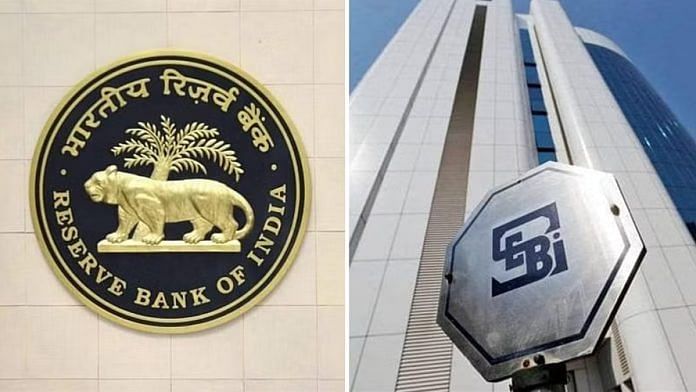New Delhi: The Securities and Exchange Board of India (SEBI) and the Reserve Bank of India (RBI) have both raised strong concerns about the high level of participation by individual investors in India’s futures and options (F&O) market.
In particular, their concerns are around the speculative nature of this market, and how anecdotes of households going into significant debt to finance this speculation are emerging. Other concerns include the macroeconomic impact of this speculative activity, and the overall situation of households’ savings falling while their debt increases.
This comes soon after both Finance Minister Nirmala Sitharaman and Chief Economic Advisor V. Anantha Nageswaran flagged concerns about India’s options market.
Options are financial instruments derived from the value of other underlying financial instruments such as stocks, indices, commodities and currencies. Since they are derived from other instruments, they form a part of what is called the derivatives market. Futures are another kind of stock market derivative instrument.
In January last year, India’s stock market regulator SEBI released a report analysing the profits and losses of individual traders dealing in the derivatives market. It found that not only did nine out of 10 traders lose money, but also that their losses were significant. SEBI even ordered its regulated entities to display this statistic prominently so that investors can make informed decisions.
“However, the trends that we are seeing in terms of even the type of trading that is happening, it being concentrated in weekly options, only on the expiry day, in the last one hour, are just speculative bets,” SEBI chairperson Madhabi Puri Buch said at a press conference Thursday.
Also read: Not enough time left, same fiscal constraints — why July budget maths will be similar to February’s
India’s booming options market a concern
Buch shared that the premium turnover in index options grew from Rs 4.5 lakh crore in FY18 to Rs 140 lakh crore in FY24, with the overall turnover in derivatives having grown from Rs 210 lakh crore to Rs 500 lakh crore over the same period.
The share of individual investors in index options went up from two percent in 2018 to 41 percent in 2024, indicating the boom in retail participation in the F&O segment.
Previously, ThePrint reported on this boom, noting that India now accounts for nearly 90 percent of all options trades in the world, and highlighting that this surge was being driven by India’s youth.
Buch added that anecdotal evidence had emerged where people were borrowing money — including by mortgaging their or their parents’ houses — to finance this speculative activity. This, she said, “was not a good thing”.
SEBI has appointed an Expert Working Group, under the Secondary Markets Advisory Committee, to review F&O markets from both an investor protection and overall systemic risk management perspective.
Also read: Why Nirmala Sitharaman 2.0 is good for finance ministry, govt & even the economy
RBI has concerns too
SEBI is not the only one concerned about this rise in F&O trading volume in India. The RBI, in the June 2024 edition of its Financial Stability Report released Thursday, also spoke about how India’s rising retail participation in the F&O market could pose several challenges.
“Retail investors could be impacted by sudden movements in markets without proper risk management and this could have knock-on effects on the cash market,” the report noted.
It also said that the rise in popularity of shorter-duration options in indices with few stocks and high volatility could lead to higher borrowings, and that the preference among investors to reduce holding periods and shift from one instrument to another could further intensify volatility.
“Therefore, it is imperative to closely monitor risks emerging from this segment and initiate appropriate and proactive policy responses,” the RBI said.
Also read: PM’s economic advisor asks if India needs a new poverty line, says multidimensional index not enough
Larger macroeconomic ramifications of rise in F&O trading
SEBI’s Buch, in the press conference, also spoke about the larger macroeconomic implications of the rapid rise in F&O trading in India.
“There is a large amount of money which is going from household savings into not productive economic activity,” she said. “This is speculative activity. This is not going into any capital formation of any kind in the economy.”
“So what is it that we as a country should be thinking about at a larger policy level,” she asked, just weeks before Sitharaman is set to present the full budget for 2024-25.
The RBI, too, took note of this rise in household liabilities, saying that this was coming at a time when household financial savings were falling.
“Financial liabilities of households have risen in the post-pandemic period, as reflected in the surge in retail loan growth for financing both consumption and investment,” the central bank’s report said.
It noted that, at 40.1 percent of GDP, the stock of household debt in India is “relatively low” when compared to other emerging economies, but in relation to GDP per capita, it is “comparatively high”.
“With overall household savings declining to 18.4 percent of GDP in FY 2022-23 from an average of 20.0 per cent of GDP over 2013-2022, and coupled with an increasing trend in financial liabilities, household debt warrants close monitoring from a financial stability perspective,” the RBI said.
(Edited by Radifah Kabir)
Also Read: ‘Walked the path of fiscal prudence’ — what economists say about interim budget 2024’s fiscal maths






